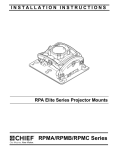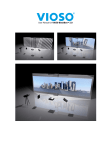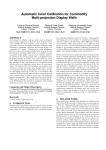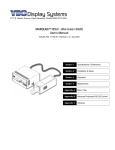Download Installation Manual
Transcript
RPMX-100U Installation Manual Contents Overview ...............................................................................................................................1 Components Shipped ............................................................................................................. 1 Installation and Setup Process ...............................................................................................2 Pre-Installation Considerations..............................................................................................2 Installation and Setup Instructions.........................................................................................3 Appendix A : Technical Information...................................................................................15 013-100163 Rev. 1 (07/05) NOTE: Due to constant research, the information in this manual is subject to change without notice (legacy: 54-017201-02P) Overview Use this guide together with the User’s Manual to successfully install and operate a GraphXMaster RPMX-100U projector (38-GFX101-XX). Information in this manual applies to all models unless otherwise specified. NOTE: For ease of use, illustrations are of the 38-GFX101-01 model, unless shown and specified otherwise. It is recommended that you keep all manuals with the projector for quick and easy reference. Only qualified and trained setup technicians should attempt to install and set up a display wall using GraphXMaster products. Abbreviations used throughout this manual: EM Electronics Module PHM Projection Head Module Components Shipped The RPMX-100U is shipped from the factory with the following components. Ensure you have received all components before you begin assembly: • 4- 6/32″ x 3/8″ hex screws (projector mounting screws) • mounting bracket (used in 90 degree configurations) • 4- ¼-20 x 2 ½ hex screws (for 90 degree bracket mounting) • 10ft. line cord (rated, North American) The User’s Kit (#38-804829-01) includes items such as manuals, keypad and other tools that are required for installation and projector setup. Ensure the user kit contains the following components: • User’s Manual • Installation Guide • IR remote keypad (includes 4 AA batteries) • assorted ball drivers (for adjusting the 6-Axis adjuster and the projection lens) • CD (includes test patterns for color matching multiple projectors) Additional Tools Required In addition to the contents of the User’s Kit, you should have the following tools on hand during installation and setup. • • Screwdriver (#1 Phillips) Level NOTE: Optional CHRISTIE components such as screens, pedestals, and other accessory kits are purchased and packaged separately. 1 RPMX-100U Installation Manual Installation and Setup Process STEP Refer to Page STEP 1 – Unpack the projector 4 STEP 2 – Modify Projector Configuration 4 STEP 3 – Projector Position and Mounting 7 STEP 4 – Connect Sources 9 STEP 5 – Power Projectors On/Off 9 STEP 6 – Adjust Projection Lens 10 STEP 7 – Adjust Image Geometry 12 STEP 8 – Software Setup 13 Please read the following safety / warning guidelines and general installation instructions before you begin. Pre-Installation Considerations When designing a projection room, various factors need to be considered such as, are you operating single or multiple units, room size, lighting and audience seating. All these factors must be taken into account in order to achieve the best possible projector output. The most important factor to consider is the human factor – the audience. Data gathered by answering questions like, “How far is the audience sitting from the display?” and “From which angle will the display be viewed?” are important first questions to ask yourself when deciding where to place the display, what type and size of screen to use. Screen Size and Type ' Choose a screen size most appropriate for your lens and application. Keep in mind if the intended use of the projector is to display text information, the image size must be large enough to allow the audience to view all text clearly. The eye usually sees a letter clearly if eye-to-text distance is less than 150 times the height of the letter. Small text located too far from the eye may be illegible at a distance no matter how sharply and clearly it is displayed. To fill a screen with an image, the aspect ratio of the screen should be equal to the aspect ratio of the image. The aspect ratio of an image is expressed as the ratio of its width to its height. It is best to choose a screen with a screen aspect ratio most appropriate for your intended application. Screens with an aspect ratio of 5:4 are recommended for use with these projectors. There are two types of screens that are best suited for rear screen installations: diffused and optical. A diffused screen has a surface, which spreads the light striking it. Purely diffused screens have a gain of less than 1. Optical screens take light from the projector and redirect it to increase the light intensity at the front of the screen. 2 RPMX-100U Installation Manual Other Considerations ' Here are some other considerations and tips that can help you improve your installation: • Ventilation is an important factor when preparing a projection room. The ambient temperature should be kept constant and below 35°C (95°F). Keep the projector away from heating and/or air conditioning vents. Changes in temperature can cause drifts in the projector circuitry, which may affect performance. • Keep the projector away from devices, which radiate electromagnetic energy such as motors and transformers. Common sources of these are slide projectors, speakers, power amplifiers, elevators, etc. • Use an optical mirror for rear screen installations to shorten the optical light path and use less space in the projection room. • Choose the right screen size for the application: ◊ ◊ ◊ • As screen size increases, magnification increases, which reduces brightness. Select a screen size, which is appropriate for the venue, but not larger than that required. Installing a large screen in a small room is similar to watching television close up; too large a screen can overpower a room. A good rule of thumb is to be no closer than 1.5 times the width of the screen. Larger screens require greater attention to lighting conditions. When designing a projection room consider positioning the projector and screen where maximum audience coverage and space efficiency is achieved. For example, placing the screen along the larger wall in a rectangular room reduces audience coverage. Installation and Setup Instructions Step 1 - Unpack the Projector The projector leaves the factory fully assembled and carefully packaged for transportation. When you receive your projector it is important you remove and discard the packaging material surrounding the modules and air vents. Check the cable connections between modules to ensure they have not become loose during shipping. In the event you have to reconnect a projector cable, refer to Appendix A. Step 2 - Modify Projector Configuration The projector configuration can be modified from 0 degrees - lens horizontal (the way its shipped from the factory) to 90 degrees - lens vertical. Use the following instructions to change the projector’s configuration. 1. With the projector off and unplugged, disconnect all harness connections between the PHM and EM. It is easiest to remove the small panel where the zipper tube enters the EM (remove 1 clamp, 4 screws). With this panel removed you can access the connections made to the Control PCB. Disconnect all harnesses between the PHM and EM. 2. Remove the four wing nuts securing the PHM assembly to the adjuster. See Figure 1. 3 RPMX-100U Installation Manual Figure 1. 3. Remove the PHM. See Figure 2. Figure 2. 4. Remove the mounting bracket on the adjuster used for mounting the PHM assembly in a lens horizontal configuration. 5. Install the mounting bracket required for lens vertical configurations on the adjuster. It is shipped with the projector – all hardware is provided. See Figure 3. Figure 3. 4 RPMX-100U Installation Manual 6. Flip the PHM so the lens is pointing up (90 degrees). Lower it back down on the adjuster aligning the mounting holes on the PHM with the new mounting bracket on the adjuster installed in Step 5. Secure the PHM in its new position using the four wing nuts removed in Step 1. See Figure 4. Figure 4. 5 RPMX-100U Installation Manual Step 3 - Projector Position and Mounting Calculating Projection ' Distance Applies to RPMX-100U (38-GFX101-01) only Figure 5. 6 RPMX-100U Installation Manual Applies to RPMX-100U (38-GFX101-02) only Figure 6. 7 RPMX-100U Installation Manual Applies to RPMX-100U (38-GFX101-05) only 8 RPMX-100U Installation Manual Mounting ' A few things to consider when mounting a projector: • Mount the projector on a sturdy, flat surface. Otherwise, you will have issues with tipping, movement, and image geometry problems. • Choose a platform that has a large enough surface area. The projector must be secured to the platform using all four of its mounting points. See Figure 7. • Allow adequate airflow around the projector, if you are going to place it in an enclosure. Refer to Appendix A for technical information. Figure 7. Mounting Information NOTE: If you are going to custom design a framing system for your projector, refer to Appendix A for technical information, such as dimensions, weight and center of gravity. 2) Allow adequate airflow around the projector if you are going to mount it in an enclosure, such as a display cube. Step 4 - Connect Sources With the projector mounted, connect the source you are going to use to the electronics module, input panel. Refer to the User’s Manual (Section 2) for details on how to connect various sources. Step 5 ñ Power Projectors On/Off Plug an approved line cord into the projector’s AC receptacle (on the Dual Lamp Module). Then plug the 3-pronged end of the line cord into a grounded AC outlet. Input voltage to the projector models must be capable of 100-240 VAC. Use the proper power source and a suitable rated line cord for your area. 1) Do not use the 120V (North American, provided) line cord in areas with 220V service. Use a suitable 220V line cord for these areas. 2) Do not use a line cord that has been damaged. 9 RPMX-100U Installation Manual Press and hold for approximately 1 second to turn the projector on or off with a single key press. Or press POWER followed immediately by ON or OFF if you want to guarantee the correct toggle (useful if you are unsure of the present status). When powering down, the cooling fans in the projector stay on for approximately 30 seconds before turning off. During this cool down period, the POWER LED is flashing red and the FAN and LAMP LED remain green during shutdown and then turn off once the fan is off. NOTES: 1) Avoid turning the projector on and off without waiting at least 30 seconds in between. In general, hot re-strikes reduce lamp life. 2) It is recommended that you do not unplug the projector until the cooling fan is off – the FAN LED is no longer illuminated. 3) It is recommended that you wait at least 10 minutes after powering down the projector and before unplugging it from the power outlet. The cooling fans in the projector DO NOT automatically turn off when the lamp is cool. This waiting period gives the lamp enough time to cool before unplugging the projector. Step 6 ñ Adjust Projection Lens Focus and Geometry Adjusting Focus ' You can manually adjust the projection lens to improve image focus. Make sure you follow the instructions that apply to your specific projector model. For RPMX-100U (38-GFX101-01) only: (Figure 8.) 1. Loosen the lock screw (C) on the lock ring (A). 2. Loosen the lock ring (A), until the lens barrel (B) can easily be turned. 3. Turn the lens barrel (B) clockwise and/or counter-clockwise until the image on the screen appears clear. 4. Re-tighten the lock ring to lock the focus adjustment. 5. Re-tighten the lock screw to prevent possible tampering with the focus adjustment. Figure 8. Do not look directly into the projection lens when adjusting focus. 10 RPMX-100U Installation Manual For RPMX-100U (38-GFX101-02 and -05): 1. Loosen the lock screw on the barrel of the lens. (Figure 9., top) 2. Grasping the lock screw, slide it to the left and right until the desired focus is achieved. (Figure 9., bottom) 3. Tighten the lock screw to lock the focus adjustment. Figure 9. Adjusting Lens Geometry ' Applies to RPMX-100U (38-GFX101-01) only The projection lens is shipped with the internal focusing lenses optimally set for a 50” diagonal screen. This setting can be modified to suit other size screens (or desired projected image size). Figure 10. illustrates the various settings available. It is recommended that you choose a setting below 84” to achieve the best geometry and focus. This procedure is only required during initial set up of the projector and is not required each time you focus. 1. Power down the projector to perform this procedure. Press POWER . 2. Loosen the lock ring on the lens. (Figure 8.) 3. Grasp the projection lens by the barrel and turn counter-clockwise until it becomes loose enough to remove. 4. Located near the end of the lens is the adjustment set screw (B) for geometry. See Figure 10. for available settings. 5. Using a 1/16” ball driver, loosen the small lock screw (C ) near the 84” setting. 6. Using a 5/64” ball driver, loosen the adjustment set screw just enough so you can slide it across to another setting. 7. Align the adjustment set screw to the desired setting and re-tighten. (It is recommended you choose any setting under 84” to achieve the best geometry and focus.) 8. Re-tighten the smaller lock screw near the 84” setting. 9. Slide the projection lens back into the PHM. 10. Re-tighten the lock ring. 11 RPMX-100U Installation Manual Figure 10. Step 7 ñ Adjust Image Geometry The projection head module is mounted to a uniquely designed 6-axis adjustment mechanism that is used during the setup process to fine-tune the geometry of the image. It does this by moving the module about the X, Y and Z-axes in varying degrees. How closely the image appears to match between screens is determined by the quality of adjustments made during this step in the setup process. To begin adjusting a wall, it is recommended that you begin with an end unit on the bottom row then adjust the units adjacent to it. Once these are closely matched, then move to the next unit and continue the process. Work your way across and up until all units have been adjusted. Once you have completed adjusting the entire wall lock the adjustments in place by tightening the four lock screws – refer to Figure 11. for location – and the smaller set screws on the collar of each adjustment screw before moving on to the next step. Do not over-adjust the screws on the adjuster. If you are finding it difficult to adjust the adjuster, it is probably because you have reached the end of the adjustment range. In this case, it is recommended that you return the adjuster back to the nominal position and begin adjustment again. ☛TIP: It is recommended that you take note of the position of the screws on the side of the adjuster before you begin adjusting. By taking notice of where these screws are located, you can quickly and easily return the adjuster back to its original position, if required. How to adjust the 6-axis adjuster mechanism: ☛TIP: Refer to Figure 12. when adjusting. This illustration identifies how to adjust the mechanism to correct the most common geometric adjustments required during setup for both possible projector configurations. 1. Unlock the adjuster, by loosening the four main lock screws (see Figure 11.) and the set screw located on the collar of each adjustment screw. 2. Center the image on the screen, by adjusting vertical and/or horizontal position. 12 RPMX-100U Installation Manual Figure 11. Adjuster Lock Screws (4) 3. 4. 5. 6. 7. Zoom the image out (make smaller) until it fits within the borders of the screen. Adjust keystone and tilt. Zoom the image in (make larger) to fill the screen. Repeat any adjustments if necessary, until the image appears correct. Lock adjustments. Figure 12. Step 8 - Software Setup Most installations require some kind of software setup to optimize settings so the projector displays the brightest and sharpest image(s). Use the following step-by-step guide and the User’s Manual for first time software setup. The User’s Manual describes in detail how to access and change projector software settings. 1. Unless otherwise indicated, instructions apply to both stand-alone and multiprojector installations Display an external signal. 2. Setup projector ID number(s). 3. Select Image Orientation in the Configuration menu to change the orientation of the displayed image to suit the installation. For example in rear screen installations select Rear from the pull down list for the image to display correctly. 4. Modify Language and any other settings in the Configuration menu to suit your needs. 5. If working with multiple projectors, enable broadcast control by selecting and toggling the option All Projectors to YES. 13 RPMX-100U Installation Manual 6. Select Auto Setup from the main menu, to give the projector a chance to setup the best possible settings for the chosen incoming signal. 7. Verify options in the menu Video Options are correct for the chosen signal. 8. Change Resize Presets if you want the image displayed at any other resolution other than native. 9. Adjust Pixel Phase and Pixel Tracking to eliminate any noise in the displayed image – accessible from the Size and Position menu. 10. Adjust H-Position and V-Position (in Size and Position menu) to re-center the image on screen. 11. Adjust Size (in Size and Position menu) first until the image is at the desired width, then adjust Vertical Stretch. Adjusting one option may have an effect on the other, repeat adjustment if necessary. 12. If required, readjust H-Position and V-Position to center the image. 13. Adjust black levels and input levels in the Input Levels menu. For quick setup, select Auto Input Levels. 14. Ensure all projectors are operating at the same power level. (Switch located on the PHM can be set at 100W or 120W). 15. Adjust color primaries. Refer to the detailed, step-by-step instruction in the User’s Manual – Matching Colors of Multiple Projectors. 14 RPMX-100U Installation Manual Appendix A Technical Information RPMX-100U (38-GFX101-01) Dimensions Lens Horizontal Lens Vertical Weight Includes adjuster, but not projection lens 15 RPMX-100U Installation Manual <44lbs RPMX-100U (38-GFX101-02) Dimensions Lens Horizontal Lens Vertical 16 RPMX-100U Installation Manual RPMX-100U (38-GFX101-05) Dimensions Lens Horizontal Lens Vertical 17 RPMX-100U Installation Manual Interconnections Drawing NOTE: The IR PCB is located in the electronic module in RPMX (38-GFX101-01) and in the PHM in RPMX (38-GFX101-02/05). In both cases, the IR PCB connects to the Control PCB. 18 RPMX-100U Installation Manual





























